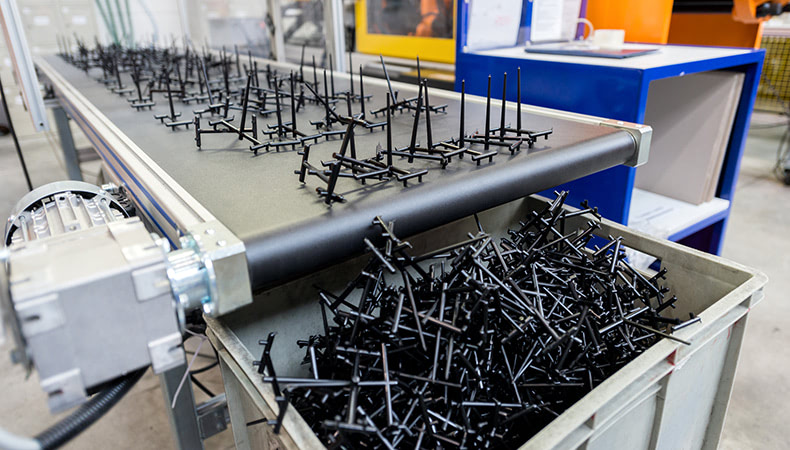Little Known Questions About Plastic Injection Molding.
Wiki Article
Some Known Incorrect Statements About Plastic Injection Molding
Table of ContentsPlastic Injection Molding Things To Know Before You Get ThisWhat Does Plastic Injection Molding Do?Facts About Plastic Injection Molding UncoveredFacts About Plastic Injection Molding Uncovered

If you want to discover additionally, the guide covers kinds of mould tools, in addition to unique completing procedures such as colours & plating. Words that are underlined can be located in the glossary in the appendix ... Component I: Moulding: The Fundamentals The Benefits of Injection Moulding Plastic shot moulding is a very specific process that offers a number of advantages over various other plastic handling techniques.
Accuracy is ideal for extremely intricate parts. You can hold this moulding in the hand of your hand and also it has bosses, ribs, metal inserts, side cores as well as openings, made with a gliding shut off feature in the mould tool.
The liquified plastic cools down & hardens into the shape inside the mould tool, which after that available to permit the mouldings to be ejected or gotten rid of for evaluation, shipment or secondary operations. Phase 1Material granules from the receptacle feed right into the heated barrel & rotating screw. Material melted by warm, friction & shear pressure is required through a check valve to the front by the revolving screw ... Part III - Past the Basics - Tooling Options Production in China can save you a great deal of expense, but it can feature issues such as shipment hold-ups, miscommunications, inferior high quality and the documents bordering importation. Using a UK moulder with existing connections to China can get rid of the threat as well as still cause cost-saving ... Tooth cavity - The component of an injection mould tool that provides the plastic product its shape, that does the real moulding of the plastic. Additionally see mould tool chapter on web pages 5 as well as 6 for all terms connected with the mould device Cycle time - The moment it considers a mould cycle to be finished, i.
Plastic Injection Molding Fundamentals Explained
from material feed & melting; product shot; cooling time and also ejection to the re-closing of the mould tool prepared for the next cycle. Draft angles - The walls of a moulded component should be a little tapered in the direction in which the component is ejected from the mould device, to allow the component to be ejected conveniently.Ejector stroke - The pressing out of ejector pins to eject the moulded part from the mould device. Ejector stroke speed, size as well as timing needs to be meticulously controlled to avoid damage to the ejectors as well as mould device, yet at the same time make the moulding cycle as short as feasible.
Get This Report on Plastic Injection Molding
Overlocking - When a mould tool has been set into a moulding device improperly, triggering the tool to shut too hard and so damaging the mould tool Component repeatability - The capacity to develop similar plastic part-times after time Span - Completely straight corners are impossible to expel from the mould device.Ribs - When a plastic component has thin walls, ribs are included in the design to make the thin wall surfaces more check my site powerful Side cores - Side activity which creates a function on a moulded part, at an opposing angle to the normal opening instructions of the mould device. The side core needs to be able to retract as the plastic component can not be ejected or else.
Walls - The sides of a moulded component The message on this page is an example from our complete White Paper 'Injection Moulding for Buyers'.
Shot moulding is widely utilized for making a range of parts, from the tiniest parts to entire body panels of autos. Injection moulding makes use of a special-purpose machine that has three components: the injection unit, the mould and the clamp.
Some Known Details About Plastic Injection Molding

In several tooth cavity moulds, each cavity can be identical and also develop the exact same parts or can be one-of-a-kind and also develop multiple various geometries throughout a single cycle. Moulds are usually made from device steels, however stainless-steels and aluminium moulds are appropriate for certain applications. Aluminium moulds are usually improper for high quantity production or components with narrow dimensional tolerances, as they have inferior mechanical properties and are more vulnerable to put on, damages, and contortion during the shot as well as securing cycles; nevertheless, aluminium moulds are cost-effective in low-volume applications, as mould manufacture expenses and also time are significantly reduced.
When sufficient material has gathered, the material is forced at high pressure as well as speed into the component developing tooth cavity. The specific quantity of contraction is a feature of the material being made use of, and also can be reasonably foreseeable. To stop spikes in pressure, the process normally uses a transfer position representing a 9598% complete dental caries where the screw changes from a consistent rate to a consistent stress control.
The packing stress is applied till the gate (tooth cavity entrance) strengthens. Due to its little size, the gate is normally the initial place to strengthen with its whole thickness.: 16 Once click here to find out more the entrance solidifies, no even more material can go into the cavity; as necessary, the screw reciprocates and gets material for the following cycle while the material within the mould cools down so that it can be expelled as well as be dimensionally secure.
Report this wiki page